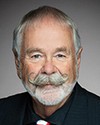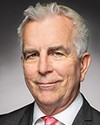Thank you, Mr. Chairman, and thank you to all of the committee for your precious time. I will speak and then I will ask Ms. Saryeddine to answer questions, as well, if that works.
Thank you for inviting the Canadian Association of Fire Chiefs here today. For the record, my name is John McKearney. I speak to you from the unceded territories of the Lil'wat Nation and Squamish Nation. I am the current fire chief for the resort municipality of Whistler, British Columbia. Prior to that I was the fire chief for the City of Vancouver and I have been in the fire service for 42 years. I am the current president of the Canadian Association of Fire Chiefs, and I am joined here today by the CAFC's executive director, Tina Saryeddine.
Our remarks will focus on four key themes: Canada's Arctic and northern policy framework, the importance of implementing the first nations fire protection strategy across the country, general issues in the fire sector, and what an action orientation to problem solving in the north might look like.
Canada's Arctic and northern policy framework provides a reasonable starting point for addressing severe disparities and inequities in the north impacting primarily indigenous peoples. It provides a vision essential for our indigenous peoples, for a collective conscience of our country and for our international security—a triple bottom line, which increases the urgency of action.
However, while it is a start, the chapter on safety, security and defence and its fifth objective to increase “whole-of-society emergency management capabilities in Arctic and northern communities” are high level. Unless we missed it, there is nothing at all on fire or on how mitigation, response or preparedness for emergencies or fire situations would occur.
How might this be addressed? Next week we will have the pleasure of partaking in a discussion with Minister Hajdu and the indigenous fire chiefs on the first nations fire protection strategy. It outlines priorities and specific goals framed within six areas—one, partnership with the first nations leadership and fire protection; two, fire prevention education; three, community standards; four, fire service operation standards; five, climate change; and, finally, six, critical infrastructure. This is a thoughtful and well-conceived strategy that focuses on education for indigenous leaders. They are the ones who make the decisions and allocate resources in their communities. If they are aware and empowered, they will make the right decisions. The strategy also links fire safety and disaster risk reduction, which creates economies of scale. It calls for the implementation of FireSmart strategies, which are essential given the increasing climate issues.
Exceptional work has also been done on the creation of the indigenous fire marshal office, now known as the National Indigenous Fire Safety Council. It has important principles for fire education, prevention and funding for indigenous communities. They still await the signing of the contribution agreements.
Moving quickly is critical because, in the north, implementation is significantly more complex than it is anywhere else in this country. In preparing our notes for today, we had the pleasure of speaking with the fire chiefs in Inuvik and in Yukon, who described how the absence of fire technicians and the existence of so many fly-in-only remote communities make simple tasks like inspecting fire and life safety equipment lengthy and expensive.
A melting permafrost creates flood issues like those never experienced before. That's along with wildfires and grass fires. Situations in which you have four or five families living in what was built as a single-family home reduce the intended lifespan of a house through greater wear, condensation, humidity and normal wear and tear. Finally, builders need to be held to account for construction quality. Currently they are not because of funding, permit and reimbursement issues.
On the issues of critical infrastructure and climate change, you already know that the federal government is leading its “Let's Talk Critical Infrastructure” and “Let's Talk Adaptation” consultations. We recommend strong linkages between those learnings and this study. If 30% to 40% of Canada's collective critical infrastructure assets are in critical condition, we can only imagine that things are far worse in the north. There may be no infrastructure in some areas, so more than three levels of government must collaborate. For example, according to the chiefs up north, the cost of water-supply infrastructure can be as high as $10,000 per meter.
These are difficult challenges, but there is an opportunity. Canada is the second-coldest country in the world. We can be world leaders in how we live successfully, peacefully, strategically and safely in northern and Arctic regions with and through the leadership of indigenous communities.
We need to have gear such as self-contained breathing apparatus that can operate effectively in these severe cold climates, a water supply that is resilient, infrastructure that succeeds in Arctic blasts, transportation systems that thrive in the cold, and even tourism that stimulates local economies.
Finland seems to have taken this approach. The CAFC was asked recently by the Finnish fire chiefs association to partake in a study to tour the northern and Arctic countries' fire and emergency systems. This is costly, but Canada may be well served in investing in such a study program to aid in knowledge generation.
While some issues in the north are unique to the north, there are other issues in fire and emergency management that are quite common to all rural communities in our country. We would like to share these with you.
First, a high reliance on volunteers in the fire sector is a precarious form of emergency response. The supply is also dwindling nationally. You may need to create incentives for fire technicians and fire professionals to experience the north and possibly subsidize transportation. It's the only way we can get expertise up there.
Second, right across the country, and I imagine no less in the north, the all-hazards response training and equipment is falling behind the times. We've recommended to the federal government to bring back something along the lines of the former joint emergency preparedness program, applicable to all parts of the country, especially since new innovation and climate situations mean new training and equipment requirements in fire departments. Addressing this will require an economy of effort and investment. Please make sure that local communities are telling you what they need.
How can all these issues that are common in the fire and emergency service be addressed, not only in the north but all across our country? We have recommended to the federal government that a structure similar to the Federal Emergency Management Agency and the U.S. Fire Administration be implemented in Canada. Recognizing that collaboration with indigenous communities would be essential, we believe the secretariat being formed around the new Minister of Emergency Preparedness is a good start. We encourage maximum collaboration.
In closing, Mr. Chair and committee, I'd like to thank you for inviting the CAFC here today. Your task is enormous but full of promise for Canadians. We often say in the Canadian Association of Fire Chiefs that we stand on the shoulders of giants. When our indigenous, northern and Arctic regions succeed, we all succeed.
Thank you, sir.




